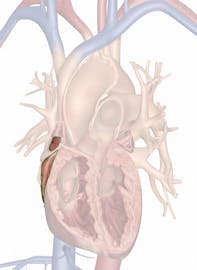The Right Atrium
Explore the anatomy and role of the right atrium with Innerbody's interactive 3D model.

The right atrium is one of the four hollow chambers of the interior of the heart. It is located in the upper right corner of the heart superior to the right ventricle. Deoxygenated blood entering the heart through veins from the tissues of the body first enters the heart through the right atrium before being pumped into the right ventricle.
The right atrium is one of the two atria of the heart, which function as receiving chambers for blood entering the heart. It is located to the right of the left atrium and superior to the much larger and more muscular right ventricle. Between the right atrium and right ventricle is a one-way valve known as the tricuspid valve. The muscular walls of the right atrium are much thinner than those of the ventricles and feature a wrinkled flap shaped like a floppy dog ear, known as the auricle. The auricle is hollow and extends outward from the anterior surface to increase the internal volume of the right atrium.
Deoxygenated blood enters the right atrium through three major veins: the superior and inferior vena cava and the coronary sinus. The superior vena cava returns all of the blood to the heart from tissues superior to the heart in the head, neck, arms and upper thorax. Likewise, the inferior vena cava returns blood to the heart from tissues inferior to the heart, including the legs, abdomen and lower thorax. Blood from the exterior of the heart itself is collected in the coronary sinus to be returned to the interior of the heart.
On the medial edge of the right atrium is a muscular wall known as the interatrial septum. The interatrial septum separates the left and right atria and prevents blood from passing between them. As an infant, a small hole in the interatrial septum known as the foramen ovale allows blood flow from the right atrium to the left atrium to reduce the flow of blood to the inactive lungs. At birth, a small flap of tissue moves to cover the foramen ovale and prevent the flow of blood between the atria. As an adult, a small indentation in the interatrial septum known as the fossa ovalis remains where foramen ovale once existed. In some cases the foramen ovale fails to close in a condition known as patent foramen ovale.
The right atrium also contains the sinoatrial (SA) node, the pacemaker of the heart. This vital piece of tissue acts as the pacemaker of the heart by controlling its rhythm and exciting the other cardiac muscle cells to contract. Autonomic nerves connect the brain to the SA node to increase or decrease the heart rate to maintain blood pressure, oxygen and carbon dioxide homeostasis.
The right atrium not only receives blood passively from the veins, but also actively pumps blood into the right ventricle. During the relaxation phase of the cardiac cycle, cardiac muscle in all of the chambers of the heart relaxes, allowing the chambers to increase their volume. Blood returning from the veins flows into the right atrium and through the tricuspid valve to the right ventricle. About 70% of the ventricular filling occurs during this phase. The right atrium next goes into systole, or contraction, to pump blood actively into the right ventricle and completely fill it. The right ventricle next goes into systole to pump blood to the lungs. The closing of the tricuspid valve blocks blood attempting to flow back to the right atrium from the right ventricle, so that blood is efficiently pumped in one direction only.


